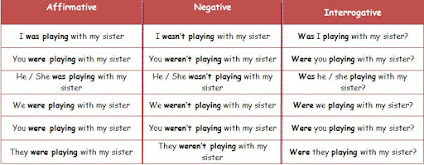|
EL ADJETIVO- THE ADJECTIVE. Comparative and superlative forms
|
Un
adjetivo es una palabra que acompaña y modifica a un sustantivo. Puede ampliar,
complementar o cuantificar su tamaño. Son palabras que nombran o indican
cualidades, rasgos y propiedades de los nombres o sustantivos a los que acompañan.
Ejemplos:
the
tall man (el hombre alto)
happy child (un niño contento)
dark street (una calle oscura)
LUGAR DEL ADJETIVO EN LA ORACIÓN
El
adjetivo casi siempre se sitúa antes del nombre, Aunque en algunos casos, depende del verbo, y
entonces el adjetivo se sitúa detrás del verbo.
GRADOS
DEL ADJETIVO: POSITIVO, COMPARATIVO
Y SUPERLATIVO
|
Existen TRES
grados de comparación del adjetivo:
Se forma con la estructura AS...AS, o NOT
AS...AS, .
Mary
is as tall as Peter. Mary es tan alta como
Peter.
Mary
is not as tall as Peter. Mary no es tan alta como Peter.
|
2- GRADO COMPARATIVO Y 3- GRADO SUPERLATIVO DE ADJETIVOS
|
1.
Para adjetivos MONOSILÁBICOS (de una sola sílaba)
les agregaremos las terminaciones ER y EST para
formar el comparativo y superlativo respectivamente:
|
POSITIVO
|
COMPARATIVO
|
SUPERLATIVO
|
|
short (corto)
|
ShortER THAN (más corto
que)
|
THE shortEST (el más corto)
|
|
long (largo)
|
LongER THAN (más largo
que)
|
THE longEST (el más
largo)
|
|
fast (rápido)
|
FastER THAN (más rápido que)
|
THE fastEST (el más
rápido)
|
2- Si el adjetivo consta de dos o más sílabas colocaremos
adelante las palabras MORE y MOST,
como vemos a continuación:
|
POSITIVO
|
COMPARATIVO
|
SUPERLATIVO
|
|
modern (moderno)
|
MORE modern THAN
(más moderno que)
|
THE MOST modern
(el más moderno)
|
|
serious (serio)
|
MORE serious THAN
(más serio que)
|
THE MOST serious
(el más serio)
|
|
expensive (costoso)
|
MORE expensive THAN
(más costoso que)
|
THE MOST expensive
(el más costoso)
|
- Si el adjetivo finaliza
en consonante seguida de la letra y, entonces cambiaremos la y por i y también agregaremos las
terminaciones ER y EST:
|
POSITIVO
|
COMPARATIVO
|
SUPERLATIVO
|
|
busy (ocupado)
|
Busier THAN
(más ocupado que)
|
the busIEST
(el más ocupado)
|
|
funny (divertido)
|
FunnIER THAN
(más divertido que)
|
THE funnIEST
(el más divertido)
|
|
easy (fácil)
|
EasIER THAN
(más fácil que)
|
THE easIEST
(el más fácil)
|
- También existen FORMAS IRREGULARES que, como
su nombre lo indica, componen su grado comparativo y superlativo con
palabras diferentes al grado positivo:
|
POSITIVO
|
COMPARATIVO
|
SUPERLATIVO
|
|
good
(bueno)
|
Better than (más bueno
que)
|
the best
(el más bueno)
|
|
bad (malo)
|
Worse than (más malo que)
|
the worst
(el más malo)
|
EXERCISES
.
Complete the sentences. Use the COMPARATIVE of SHORT ADJECTIVES.
1. Tokyo is…………… than Shanghai. (large)
2.
Europe is …………….. than South America.
(small)
3.
The Amazon river is……………….. than the
Mississipi river. (long)
4.
Antarctica is …………………. than Africa.
(cold)
5.
The Caspian sea is ………………. than lake Michigan. (deep)
2. Complete the sentences. Use
the COMPARATIVE of LONG ADJECTIVES.
1. Gold is
………………..than silver. (expensive)
2. Reality TV programmes are …………………….. than
chat shows. (interesting)
3.
Science is difficult but Maths is …………………….. (difficult)
4. I think that Halle Berry is …………………………. than
Sharon Stone. (beautiful)
5.
Tigers are ……………………………. than crocodiles.
(dangerous)
1.
Complete the sentences. Use the SUPERLATIVE of SHORT ADJECTIVES.
1. Antarctica is the ………………..
place on Earth. (cold)
2.
Vatican City is the ………………………….. country in the world. (small)
3.
The Atacama desert, in Chile, is the………………..
place in the world. (dry)
4.
Mount Everest is the………………….. mountain
on Earth. (tall)
5.
The Nile river, in Egypt, is the
………………………..river in the world.
(long)
Complete the sentences. Use the SUPERLATIVE of LONG ADJECTIVES.
1.
Bears are the ………………………………… animals.
(dangerous)
2. Rio de Janeiro is one of the……………………. cities in the world. (beautiful)
3. The Bugatti Veyron is the ………………and……………. car.
(powerful) (expensive)
4. American Idol is the …………………………………….TV show in America. (popular)
5. Bungee jump is one of the …………………….. adventure sports. (exciting).
AHORA COMPLETA EL SIGUIENTE CUADRO A
TIPO DE RESUMEN
EQUALITY ADJECTIVES ……… ................
|
|
COMPARATIVE-
SUPERLATIVE
|
|
|
SHORT ADJECTIVES ………... …………….
|
|
|
|
|
LONG ADJECTIVES ……………. ...............
|
------------------------------------------------------------------------------------------------------------------------
USA ESTOS ADJETIVOS PARA OPINAR SOBRE LAS TIC COMMUNICATION TECHNOLOGIES.
|
MODERN- CHEAP- PRACTICAL- BIG-
EXPENSIVE- NOISY- HEAVY- LIGHT- POPULAR- GOOD
|
|
COMPARA CADA PAR DE LOS SIGUIENTES MEDIOS DE COMUNICACIÓN.
ESCRIBE UNA ORACIÓN COMPARATIVA Y UNA
SUPERLATIVA
|
1-
Computer/ mobile phone
……………………………………………………………………………………………………
2-
Television/ computer
……………………………………………………………………………………………………
3- Mobile telephone/ I-phone
……………………………………………………………………………………………………
4-
Google tools/
Youtube
……………………………………………………………………………………………………
5-
Skype/ Google meet
…………………………………………………………………………………………………………
6-
Twitter/ what´s app
……………………………………………………………………………………………………
7-
Youtube/ Netflix
……………………………………………………………………………………………………
|
b- WHICH IS YOUR FAVOURITE ELECTRONIC GADGET? WHY?
|
……………………………………………………………………………………………………………
----------------------------END OF LESSON 2-------------------------


